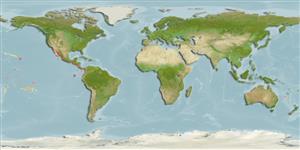>
Blenniiformes (Blennies) >
Dactyloscopidae (Sand stargazers)
Etymology: Gillellus: Theodore Nicolas Gill (1837-1914) researcher of abyssal fishes and systematics (Ref. 45335).
More on author: Gilbert.
Environment: milieu / climate zone / depth range / distribution range
पारिस्थितिकी
समुद्री ड़िमरसल; गहराई सीमा 8 - 137 m (Ref. 11482). Tropical
Eastern Central Pacific: southern tip of Baja California to Panama.
आकार / वज़न / Age
Maturity: Lm ? range ? - ? cm
Max length : 5.5 cm TL पुल्लिंग / अलिंग; (Ref. 11482)
Found on sandy bottoms. Feeds on small fishes and invertebrates.
Life cycle and mating behavior
परिपक्व अवधि | पुनरुत्पत्ति | मछलीऔ का अंडे देना | अंडे | Fecundity | लार्वा
Allen, G.R. and D.R. Robertson, 1994. Fishes of the tropical eastern Pacific. University of Hawaii Press, Honolulu. 332 p. (Ref. 11482)
IUCN Red List Status (Ref. 130435: Version 2024-2)
Threat to humans
Harmless
Human uses
साधन
Special reports
Download XML
इंटरनेट स्रोत
Estimates based on models
Preferred temperature (Ref.
123201): 17.2 - 27.4, mean 23.4 °C (based on 28 cells).
Phylogenetic diversity index (Ref.
82804): PD
50 = 0.5010 [Uniqueness, from 0.5 = low to 2.0 = high].
Bayesian length-weight: a=0.00389 (0.00180 - 0.00842), b=3.12 (2.94 - 3.30), in cm total length, based on all LWR estimates for this body shape (Ref.
93245).
Trophic level (Ref.
69278): 4.0 ±0.61 se; based on food items.
Fishing Vulnerability (Ref.
59153): Low vulnerability (10 of 100).
